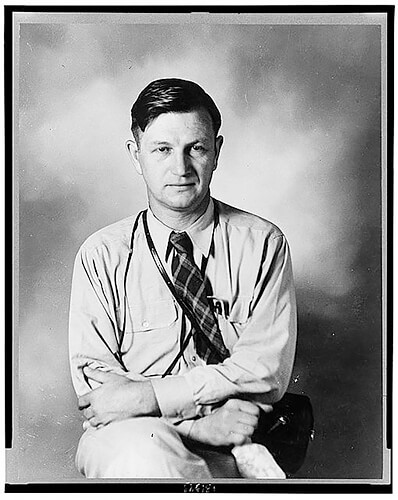Russell Lee (July 21, 1903, Ottawa, Illinois – August 28, 1986, Austin, Texas) was an American photographer and photojournalist, best known for his work for the Farm Security Administration (FSA). His technically excellent images documented the ethnography of various American classes and cultures.
Lee grew up in Ottawa, Illinois and went to the Culver Military Academy in Culver, Indiana for high school. He earned a degree in chemical engineering from Lehigh University in Bethlehem, Pennsylvania.
(Source: en.wikipedia.org)
He gave up an excellent position as a chemist to become a painter. Originally he used photography as a precursor to his painting, but soon became interested in photography for its own sake, recording the people and places around him. Among his earliest subjects were Pennsylvanian bootleg mining and the Father Divine cult.
In the fall of 1936, during the Great Depression, Lee was hired for the federally sponsored Farm Security Administration (FSA) photographic documentation project of the Franklin D. Roosevelt administration. He joined a team assembled under Roy Stryker, along with Dorothea Lange, Arthur Rothstein and Walker Evans. Stryker provided direction and bureaucratic protection to the group, leaving the photographers free to compile what in 1973 was described as "the greatest documentary collection which has ever been assembled." Lee created some of the iconic images produced by the FSA, including photographic studies of San Augustine, Texas in 1939, and Pie Town, New Mexico in 1940. Over the spring and summer of 1942, Lee was one of several government photographers to document the eviction of Japanese Americans from the West Coast, producing over 600 images of families waiting to be removed and their later life in various detention facilities.
After the FSA was defunded in 1943, Lee served in the Air Transport Command (ATC), during which he took photographs of all the airfield approaches used by the ATC to supply the Armed Forces in World War II. He worked for the United States Department of the Interior (DOI) in 1946 and 1947, helping the agency compile a medical survey in the communities involved in mining bituminous coal. He created over 4,000 photographs of miners and their working conditions in coal mines. In 1946, Lee completed a series of photos focused on a Pentecostal Church of God in a Kentucky coal camp.
While completing the DOI work, Lee also continued to work under Stryker, producing public relations photographs for Standard Oil of New Jersey. Some 80,000 of those photographs have been donated by Exxon Corporation to the University of Louisville in Kentucky.
In 1947 Lee moved to Austin, Texas and continued photography. In 1965 he became the first instructor of photography at the University of Texas.
In addition to the materials at the University of Louisville, other important collections of Lee's work are held by the New Mexico Museum of Art,[6] Wittliff collections, Texas State University and the Dolph Briscoe Center for American History at the University of Texas at Austin.
